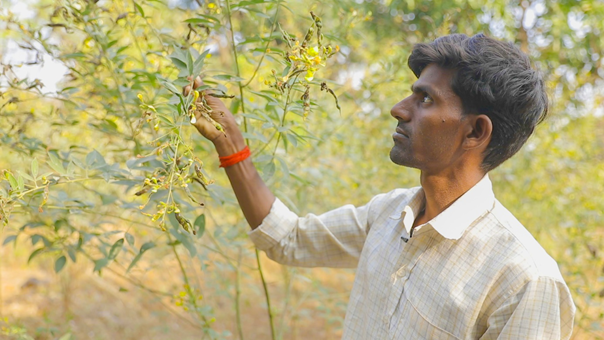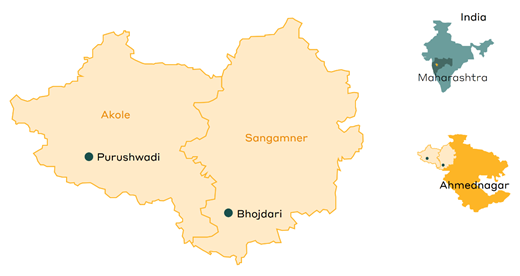Written by Devaraj de Condappa, TMG Research, and Stephen Roche
In recent decades, India has suffered greater economic losses and human fatalities due to extreme weather events — such as droughts, storms or flooding — than any other country[1]. Millions of people are regularly displaced due to extreme weather. Many Indians acutely understand the urgency of adapting to climate change, particularly in agriculture, as at least half of the country’s population depends on this sector for its livelihood[2].
Kishan Kashinath Kondar is an Indian farmer who has managed to minimise the detrimental impacts of extreme weather by practising sustainable farming. That has involved using indigenous seeds and organic pesticides and fertilisers to cultivate more than a dozen varieties of crops across three seasons. Moreover, he has planted a wide range of fruit trees, and also rears livestock. This diversification and reliance on resilient crops have allowed him to consolidate his income and adapt to a changing climate.

Kishan has taken part in watershed development and climate change adaptation programmes implemented by an NGO, the Watershed Organisation Trust (WOTR), since the mid-1990s. Recognising that healthy ecosystems help people cope with climate change, WOTR applies Ecosystem-based Adaptation (EbA) to build communities’ resilience while protecting and restoring ecosystems.
TMG Research, a Berlin-based think-tank, collaborated with WOTR to assess the outcomes of its projects. Two case studies were examined: Purushwadi and Bhojdari villages, both located in Ahmednagar district, Maharashtra.


The report considered three core elements of EbA: the adaptive capacities of communities, ecosystem services and biodiversity, and participatory governance. Positive outcomes were found for all three elements and the benefits for villagers were truly multi-dimensional. Farmers’ adaptive capacity improved thanks to more sustainable agricultural methods based on the System of Crop Intensification[3] and multi-layered farming with a mix of crop varieties.

The reintroduction of indigenous crops played a crucial role during the drought of 2018, when indigenous pearl millet was the only rain-fed crop that thrived. Moreover, the diversification of economic activity with ecotourism helped to boost farmers’ incomes. Food security and nutrition also improved, both from the switch to indigenous crops like Varai and the widespread adoption of kitchen gardens.
Alongside its economic and nutritional benefits, EbA strengthened participatory governance in both villages. Village committees were created to manage soil and water conservation infrastructure. A People’s Biodiversity Register was set up to record local knowledge of biological resources and pass this on to the younger generation. WOTR also promoted community management of water resources through the Water Stewardship Initiative and helped the villages strengthen their collaboration with government departments.
Since WOTR began its work in the two villages studied, local ecosystems and biodiversity have measurably improved. There is now greater agro-biodiversity thanks to the reintroduction of indigenous crops and the rearing of backyard indigenous poultry. Finally, large-scale soil and water conservation efforts have increased vegetation on degraded lands and boosted agricultural production due to better soil quality and moisture retention.
These results demonstrate the potential of EbA to help Maharashtra implement its action plans on climate change, biodiversity, and land degradation. A roadmap is currently being drafted through a multi-stakeholder consultation process to scale-up the adoption of EbA in Maharashtra.
Key messages for scaling up EbA in Maharashtra
1. EbA strengthens community resilience while preserving ecosystems.
2. EbA increases the resilience of agricultural systems to climate change while strengthening food and nutrition security.
3. EbA must be economically viable; it is therefore imperative to strengthen the income of rural communities and ensure ecosystem-based livelihoods.
4. EbA can deliver cultural and health benefits since well-being depends on healthy ecosystems.
5. EbA builds stronger communities, fosters local democratic processes, and pools different types of knowledge.
6. EbA requires strong collaboration between communities, civil society, the private sector, government and funding agencies.
Globally, the COVID-19 crisis has shown that human encroachment into fragile ecosystems can cause the emergence of zoonotic diseases[4]. In India, moreover, the crisis has caused massive remigration from urban to rural areas. In these two respects, the pandemic has shown that we need to manage ecosystems wisely and strengthen rural livelihoods, as was achieved in the case study villages for farmers like Kishan. Meanwhile, the climate crisis has not gone away. The roadmap to upscale EbA offers a practical opportunity to build back better — for more sustainable and resilient communities and ecosystems.
About the project
For more information about our work on Ecosystem-based Adaptation visit our project websites: www.tmg-thinktank.com/eba and https://wotr.org/eba/
To engage in our discussions on Ecosystem-based Adaptation, follow us on twitter: https://twitter.com/TMG_thinktank
The “Climate-SDG Integration Project — Supporting the implementation of the Paris Agreement and the 2030 Agenda through Ecosystem-based Adaptation” is part of the International Climate Initiative and financed by the German Federal Ministry for the Environment, Nature Conservation and Nuclear Safety (BMU).
[1] Rory Gibb et al., ‘Zoonotic Host Diversity Increases in Human-Dominated Ecosystems’, Nature 584, no. 7821 (1 August 2020): 398–402, https://doi.org/10.1038/s41586-020-2562-8.
[2] An agricultural practice which involves four successive steps: soil preparation and management, ample and regular crop spacing, application of locally prepared organic inputs, and micro-nutrient foliar spraying
[3] David Eckstein, Vera Künzel, and Laura Schäfer, Global Climate Risk Index 2021 Who Suffers Most Extreme Weather Events? Weather-Related Loss Events in 2019 and 2000–2019, ed. Joanne Chapman-Rose and Janina Longwitz (Bonn, Germany: Germanwatch e.V., 2021).
[4] DES, ‘Agricultural Statistics at a Glance 2019’ (New Delhi, India: Directorate of Economis and Statistics, Government of India, 2020).
The article was initially published on Medium: https://medium.com/enabling-sustainability/from-watershed-development-to-ecosystem-based-adaptation-a-journey-to-systemic-resilience-e10a81b436c6





